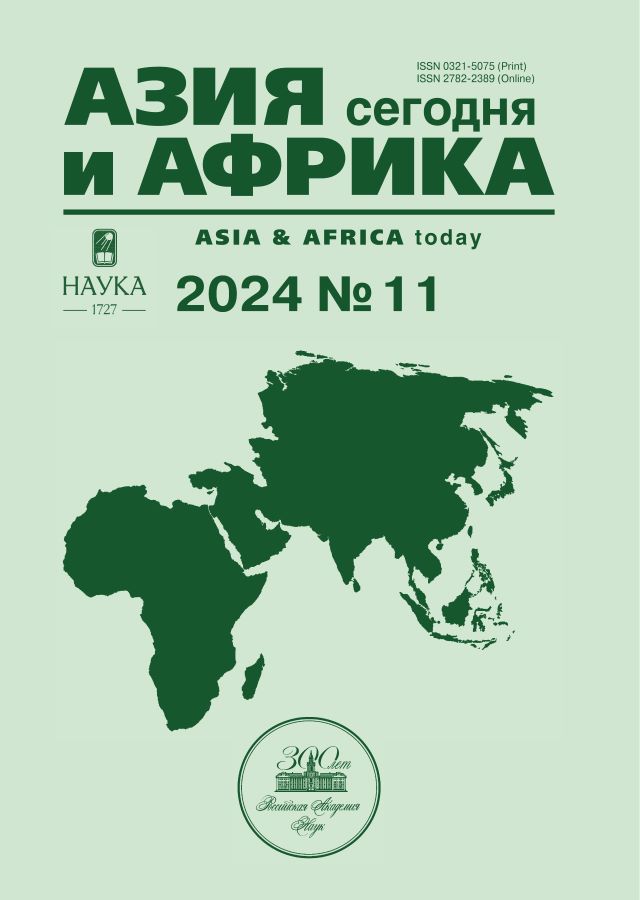Water of the Nile. Present. Past. Future
- Autores: Vasiliev A.M.1, Elkina E.A.1
-
Afiliações:
- Institute for African Studies, Russian Academy of Sciences
- Edição: Nº 11 (2024)
- Páginas: 31-39
- Seção: Politics, economics
- URL: https://kld-journal.fedlab.ru/0321-5075/article/view/647469
- DOI: https://doi.org/10.31857/S0321507524110047
- ID: 647469
Citar
Texto integral
Resumo
Hydropolitics has become an important component of international relations both in North Africa and in the countries south of the Sahara. The most prominent example is the disputes between Egypt and Ethiopia over the distribution and management of the Nile’s waters. Approximately 3/4 of the Nile’s water originates from the Ethiopian Highlands, and the construction of the Grand Ethiopian Renaissance Dam on the Blue Nile is seen by Ethiopia as its sovereign right. The goal is to increase electricity production in this very poor country to boost the economy and address social issues. Egypt, on the other hand, relies on the Nile for 97% of its water supply. Its agriculture is based on irrigated farming, and the hydroelectric station of the Aswan High Dam contributes significantly to the country’s economy. The construction and filling of the Ethiopian dam have led to high tensions between Cairo and Addis Ababa. Numerous negotiations have reached an impasse. In 2024, the conflict expanded to the Horn of Africa. Egypt, alongside Eritrea, began supporting the internationally recognized government of Somalia, while Ethiopia established cooperation with the breakaway region of Somaliland. So far, the confrontation has not escalated to the use of military force.
Palavras-chave
Sobre autores
Alexey Vasiliev
Institute for African Studies, Russian Academy of Sciences
Email: dir@inafr.ru
ORCID ID: 0000-0003-1216-1509
member, Russian Academy of Sciences, Dr.Sc. (History), Professor; Honorary President; consulting professor of the Center of Oriental and African Studies; Editor-in-Chief, “Asia and Africa today” journal Moscow, Russia
Ekaterina Elkina
Institute for African Studies, Russian Academy of Sciences
Email: easerova@list.ru
ORCID ID: 0000-0002-8021-5970
Researcher, Center for North Africa and Horn of Africa Studies Moscow, Russia
Bibliografia
- Отинов Д., Третий раунд заполнения GERD: возможен ли выход из тупика? Международная жизнь. 2022 № 8. https://interaffairs.ru/jauthor/material/2705 (accessed 10.10.2024)
- Конохова М.В. Внешнеэкономический потенциал Эфиопии. Ученые записки института Африки РАН. 2022. № 3. С. 39-50. doi: 10.31132/2412-5717-2022-60-3-39-52
- Carlson Andrew. Who owns the Nile? Egypt, Sudan and Ethiopia’s History-Changing Dam. https://origins.osu.edu/article/who-owns-nile-egypt-sudan-and-ethiopia-s-history-changing-dam (accessed 09.10.2024)
- Чол Денг Алак (Судан). История международного регулирования вод Нила: политические, социально-экономические и правовые аспекты. Дисс. ... к.и.н. М.: ИАфр РАН, 2008.
- Васильев А.М., Елькина Е.А. Раздел вод Нила: взгляд через призму истории. Вопросы истории. 2018. № 10. С. 20-28.
- Елькина Е.А. Гидрополитика в бассейне Нила. Азия и Африка сегодня. 2015. № 8. С. 30-33.
- Елькина Е.А. Озеро Чад: экология и гидрополитика. Азия и Африка сегодня. 2017. № 3. С. 49-52.
- Мезенцев С.В., Царев П.Г. Нильский торг. Ученые записки института Африки РАН. 2020. № 3. Pp. 112-132. doi: 10.31132/2412-5717-2020-52-3-112-132
- Брагин А.Н. Эфиопия: «Великая дамба Возрождения». Азия и Африка сегодня. 2012. № 1. С. 56-58.
- Чол Денг Алак (Судан). Удастся ли заново поделить нильскую воду? Азия и Африка сегодня. 2008. № 12.
Arquivos suplementares










